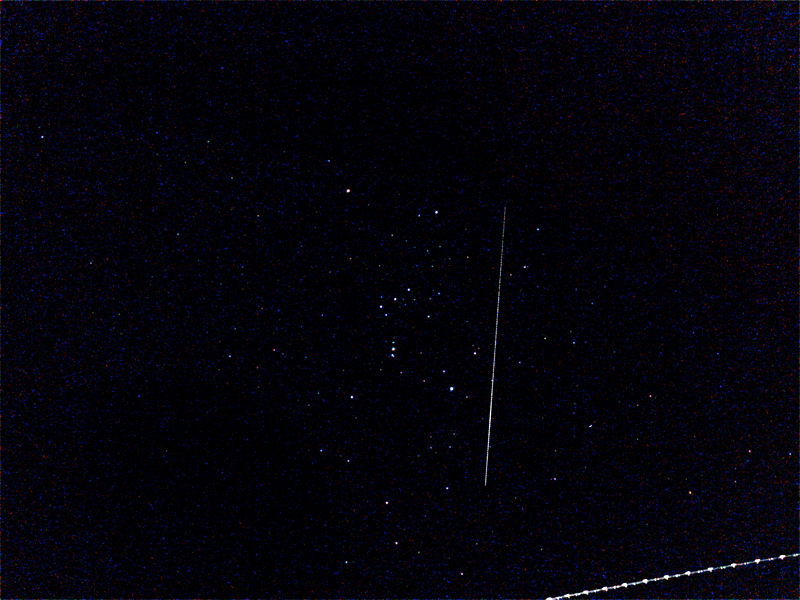iPhone Piggyback Imaging: Orion using NightCap Pro
Posted: 14 February 2015
The sky was clear Wednesday night, 11 February 2015, but the wind was blowing just enough to have made being in the observatory a problem. Clouds arrived Thursday morning, 12 February, with even stronger winds blowing. Had an Oracle Dark Skies Committee meeting that evening to finalize planning for the big IDA "International Dark Sky Park" celebration event at Oracle State Park on 21 March 2015. The sky was clear on Friday, with the winds calming down.
|
Open: Friday, 13 February 2015, 1815 MST Temperature: 77°F |
Session: 782 Conditions: Mostly clear, some clouds on horizon |
1822 MST: quick look at Venus through the 8" telescope, 83X.
On a previous report, I showed an iPhone image of Orion with the iPhone mounted piggyback using a GorillaPod. There were a couple of problems using the GorillaPod to hold the iPhone on the telescope finderscope:
1. The GorillaPod would easily move on the slick surface of the finderscope unless one of its legs was braced against a finderscope mount adjustment screw.
2. Adjusting orientation of the camera was difficult and required that the GorillaPod be repositioned to change from landscape to portrait.
This night I decided to try my Magnilux MX-1 Afocal Adapter, which can also be used to mount an iPhone 4 or iPhone 5 with a slight modification on a photographic tripod or anything with a camera attachment screw. Since I have a camera piggyback adapter permanently attached on my 8" LX200-ACF, I thought this would be a good test of the MX-1 and NightCap Pro.
As can be seen in these two photographs, the iPhone can be oriented portrait or landscape, or in fact, in any orientation needed:


You can also see the earbuds/mic cord which I use as a remote shutter release for the iPhone camera.
NOTE: the GorillaPad smartphone clamp can be removed from its legs and attached directly on a camera tripod or piggyback adapter. That would provide a secure mounting but the orientation would be fixed.
This sky photo was taken with the iPhone 5s piggybacked and shows the view that can photographed:

Mouseover or tap on image to see label
As is obvious, the telescope tube (OTA) is visible as the camera is positioned close to the tube. That could be minimized by using an extender on the piggyback adapter or by attaching the piggyback adapter at the objective end of the OTA. (Venus is visible in the above image. Mouseover or tap the image to see a pointer.)
1846 MST: took this handheld photo of the western sky from inside the SkyShed POD using the Nikon D7000 DSLR, f/4, 1/5sec, ISO 2500, FL 25mm:

Mouseover or tap on image to see labels and a magnified inset
Mars is faintly visible just above Venus. Mouseover or tap on the image to see labels and a magnified inset showing a red Mars and an overexposed Venus.
Mars and Venus are approaching a close conjunction of 0.4° which will occur on 21 February 2015. This night they were about 4° apart. They were both visible in the 4.6° field-of-view of my Celestron Comet 12x70 binoculars.
1905 MST: Zodiacal Light was visible.
1915 MST: clouds in the southern sky were getting higher in the sky. Began setting up for iPhone piggyback imaging of the constellation of Orion using the MX-1 adapter. Previously I used Long Exposure with Light Boost mode in NightCap Pro. At the developer's suggestion, this night I used Light Trails with Light Boost. The following edited images were taken using a 5 minute exposure (top) and a 10 minute exposure (bottom):


The top photo captured a polar-orbiting satellite (vertical streak) and an airplane (streak at the bottom). The bottom photo captured three airplanes (bottom). The sky above Orion is blocked by the observatory dome and there is a blocked area in the lower lefthand corner from the telescope tube. But otherwise, there are very impressive night sky images taken with a smartphone thanks to the capabilities of NightCap Pro.
1941 MST: ended piggyback imaging. Clouds in the southern sky had reached Orion.
1952 MST: viewed Jupiter, 83X. Four moons were visible but seeing was very bad. Checked the IR satellite for this area; a large area of clouds was rapidly approaching. I decided to end the session. As I closed the observatory, the clouds had reached Jupiter.
|
Close: Friday, 13 February 2015, 2006 MST Temperature: 58°F |
|
Comments are welcome using Email. If you are on Twitter you can use the button below to tweet this report to your followers. Thanks.
Cassiopeia Observatory Home Page
Copyright ©2015 Michael L. Weasner / mweasner@me.com
URL = http://www.weasner.com/co/Reports/2015/02/14/index.html
